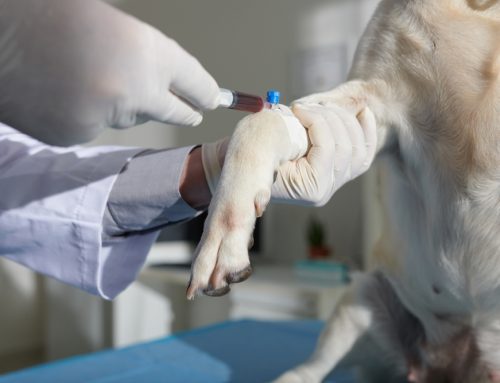Flea Allergy Dermatitis in Pets: Understanding, Preventing, and Treating This Common Condition
Fleas are more than just a nuisance. For some dogs and cats, even a single flea bite can trigger a severe allergic reaction that leads to intense itching, hair loss, and secondary skin problems. This condition, known as flea allergy dermatitis (FAD), is one of the most common skin diseases seen in pets.
What makes FAD especially frustrating is that it can affect any pet– even those living indoors and even those on regular flea prevention. Fortunately, with the right prevention, treatment, and home care, pets with flea allergy dermatitis can live comfortable, (mostly) itch-free lives. At Pinedale Animal Hospital, we help families protect their pets with customized prevention plans, wellness packages, and advanced therapies to keep flea problems under control.
What Is Flea Allergy Dermatitis?
Flea allergy dermatitis occurs when a pet’s immune system overreacts to proteins in flea saliva. Instead of just feeling temporarily itchy from a bite, affected pets experience a full-body allergic reaction.
This condition is especially common in cats and can result in intense itching, scabbing, and hair loss. Unlike seasonal allergies, which are tied to pollen or environmental triggers, FAD is caused by a parasite that can be prevented and controlled.
Why Even Indoor Pets Are at Risk
It’s a common misconception that indoor pets don’t need flea prevention. Fleas can easily hitch a ride indoors on people’s shoes, clothing, or other animals. Once inside, they can reproduce quickly and continue to bite.
Even more concerning: it only takes one flea bite to trigger an allergic reaction in a sensitive pet. That’s why dogs and cats may still have symptoms even if you don’t see fleas crawling through their coat.
Imagine this: You have an indoor only cat, who is not on flea prevention. Your dog, who is on flea prevention, goes for a walk. They pick up a flea or two while wandering- a very common scenario. If that flea bites your dog, the preventive medication works and the flea dies within a couple of hours before it can lay eggs all over your home. But what if it doesn’t bite your dog right away, and instead hitchhikes into your home and jumps on your indoor-only cat? Now your cat is itchy and miserable, and that flea has the opportunity to progress to the next stage of its lifecycle– laying up to 50 eggs a day (that’s 600 eggs a month!). Fleas can get out of control incredibly quickly when not every pet in the household is on year-round preventatives.
Classic Signs of Flea Allergy Dermatitis
FAD looks different from ordinary flea exposure. Pets with allergies experience much more dramatic reactions, even from very few fleas.
Common signs include:
- Severe itching that seems out of proportion to the number of fleas present. Many pets scratch, chew, or lick so intensely that their skin becomes raw. Severe itching is often the first and most obvious sign.
- Hair loss and scabs, especially at the base of the tail, rump, or thighs.
- Redness, swelling, or skin infections that can resemble allergy symptoms.
- Cats may over-groom and develop “miliary dermatitis”—tiny scabs along their back and neck.
At Pinedale Animal Hospital, our diagnostic services include skin testing, cytology, and digital imaging to help us confirm flea allergy dermatitis and rule out other causes of itching.
The Flea Life Cycle: Why Prevention Matters
Understanding how fleas reproduce explains why infestations are so difficult to eliminate. Fleas move through four stages:
- Egg – Laid on the pet but quickly fall into the environment.
- Larva – Hatch and burrow into carpets, bedding, and cracks.
- Pupa – Resistant cocoon stage that can survive for weeks or months.
- Adult – Jumps onto a pet to feed and reproduce, and starts the cycle all over again.
Because most of the flea population lives in the environment rather than on the pet, infestations can continue unless every stage is targeted. This is why year-round parasite prevention is critical.
Prevention: Protecting All Pets in the Household
One of the most important rules for FAD management is that every pet in the home must be treated. If even one pet is left unprotected, fleas can reproduce and keep the cycle going.
At Pinedale Animal Hospital, we make prevention easier through Pet Annual Health Packages that include options for 12-month flea and tick protection. Our wellness and prevention plans are designed to fit your pet’s age, lifestyle, and risk factors.
It’s also important to know that:
- Even pets on prevention can occasionally be bitten, but prevention stops fleas from reproducing in the home environment.
- Over-the-counter flea preventives are less effective today due to resistance and lower-quality formulations. Prescription preventives are safer and more reliable.
- Consistency is key: missing even one dose can allow fleas to come back.
Treatment Options for Flea Allergy Dermatitis
Veterinary Flea Prevention
Prescription preventives are the foundation of FAD management. Options include monthly oral or topical medications that kill fleas quickly and break the reproductive cycle. Our team works with families to select the safest and most effective products for each pet.
Topical Support for Skin Relief
Once fleas are controlled, the skin still needs time to heal. Topical therapies such as medicated shampoos, mousses, or sprays can reduce itching, calm inflammation, and help prevent secondary infections. At Pinedale, we may also recommend laser therapy for pets with chronic skin irritation, as it helps reduce inflammation and supports faster healing without medication.
Eastern Medicine
For families interested in integrative options, Pinedale Animal Hospital offers Eastern medicine therapies such as acupuncture and herbal medicine. These can complement traditional treatments by supporting skin health, reducing inflammation, and improving comfort.
Environmental Management
Because fleas spend much of their life cycle in the home, environmental control is essential. Steps include:
- Vacuuming carpets, rugs, and furniture frequently.
- Washing pet bedding in hot water weekly.
- Treating the home and yard if infestations are severe.
- Practicing regular grooming to spot fleas and flea dirt early.

FAQs About Flea Allergy Dermatitis
Can indoor pets really get fleas?
Yes. Fleas can enter on people, other animals, or even through screens. Indoor pets are still at risk.
Why does my pet still scratch even though I don’t see fleas?
Pets with FAD can react to just one bite. Fleas may not stay on your pet long enough to be noticed.
Can my pet still get bitten on flea prevention?
Yes. Prevention doesn’t create an invisible shield; it works by killing fleas quickly and stopping reproduction. This greatly reduces infestations but doesn’t eliminate every bite.
Why doesn’t over-the-counter flea medicine work?
OTC products often contain older ingredients that fleas have developed resistance to. Prescription preventives are safer and more effective.
Do all my pets really need flea prevention?
Yes. If even one pet isn’t treated, fleas can reproduce and reinfest the environment.
How can I help my pet’s skin heal?
Topical therapies, medicated shampoos, and supportive care such as laser therapy can help soothe itching and speed healing.
What happens if flea allergies are untreated?
Pets can develop painful infections, chronic skin disease, or even anemia in severe cases.
Your Partner in Preventing Flea Allergy Dermatitis
Flea allergy dermatitis is one of the most common and preventable skin diseases in dogs and cats. While it only takes a single flea bite to cause a reaction, consistent prevention, environmental care, and supportive therapies can make a world of difference.
If you suspect your pet is suffering from flea allergy dermatitis, the caring team at Pinedale Animal Hospital is here to help. From wellness and prevention to diagnostics and advanced treatments like laser therapy and Eastern medicine, we provide comprehensive, hometown veterinary care with a personal touch.
Contact us today to schedule an appointment or learn more about our annual health packages that include flea and tick prevention. Together, we can keep your pet comfortable, healthy, and itch-free year-round.








Leave A Comment